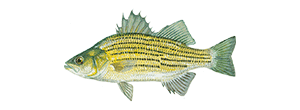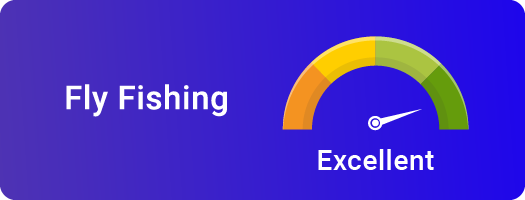Yellow Bass

Species Details
Morone Mississippiensis
Moronidae
Perciformes
Lake, River
1 - 1 lbs.
12" - 18"
Description
The Morone Mississippiensis or Yellow Bass has 5-7 rows of stripes running across its yellow body. Its dorsal fin is also split into two sections. The first section of the Yellow Bass’ dorsal fin is composed of nine spines then the second has 1 spine but a full length of 12 rays. The Yellow Bass is also different from its white cousin, having around only 10 give or take a few anal rays only. It also doesn’t have a small patch of teeth on the tongue which the latter seems to have.
The dorsal portion of a Yellow Bass is dark olive green but its whole body is predominantly silvery yellow.
Diet and Size
Yellow Bass love feeding on small crustaceans known as copepods but also feed on aquatic insects. However, this is only when they’re still juvenile. When Yellow Bass grow older, their diet becomes a mix of aquatic insects and possibly smaller fish.
Usually, a Yellow Bass weighs around 4-12 ounces. However, there are some rare occurrences that they do exceed a pound. Someone managed to catch a Yellow Bass at 2 pounds and 4 ounces.
Interesting Facts
- Yellow Bass are capable of growing big but cannot because their growth gets stunted.
- Like any fish, they grow depending on the amount of space they have.
- Yellow Bass reproduce a lot which is why sometimes, their areas can get crowded.
- This is seen as one of the biggest factors why Yellow Bass are small.
- Yellow Bass have a short lifespan. They only live up to 7 years.
- A lot of people think that because the Yellow Bass is small, it’s not as valuable as the other gamefish that are bigger.
- Yellow Bass are a school-kind of fish. They like traveling in groups where they have a chance to feast on minnows.
- Yellow Bass are known to be fast swimmers.
- This may also be due to their size being small so they can easily slip away if needed.
Fishing Techniques
Fishing for a Yellow Bass requires one to use live bait. Though, it highly depends on the season. In spring, anglers recommend using minnows as bait for catch Yellow Bass. During the summer, anglers would recommend using Nightcrawlers. They even said that using cut bait would be okay. It saves on bait and at the same time you don’t have to keep swapping or get new bait every time. Since Yellow Bass are also receptive to flyfishing, using beaded nymphs are okay also.
Yellow Bass are light so using a lightweight tackle will do. Artificial lures weighing at least 1/16 of an ounce will do. Though, some have reported going as small as 1/64. After that, drop your lure in near the bottom. Since they usually feed on bottom feeders, it’s best to keep your lure 6 inches off the floor so that it doesn’t get tangled anywhere else.
Yellow Bass are quite the fighter and when you find a school, it’s okay to stalk them for a bit. Stalk a little, watch the pathway and movement of the school before dropping the lure. Once you get a bite, you’ll probably have to fight with several Yellow Bass.
Habitat
Yellow Bass like structures as their habitat. They go after substrates made of rock, sand, and gravel. However, Yellow Bass prefer shallow waters. They usually lurk in around 2 to 3 feet of water near the shore so rocky shores may be your best bet in finding a Yellow Bass.






